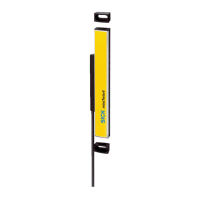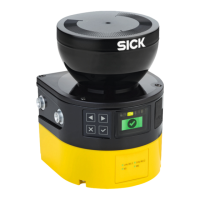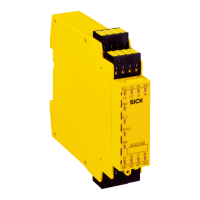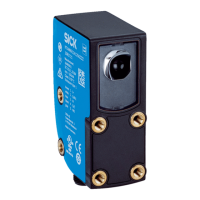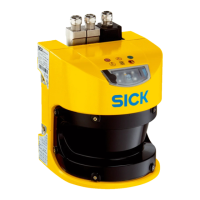Operating Instructions Chapter 5
M4000 Adv., Adv. A/P, Area
8010797/YT72/2016-02-19 © SICK AG • Industrial Safety Systems • Germany • All rights reserved 41
Subject to change without notice
Configurable functions
5.3 Application diagnostic output (ADO)
T
he M4000 has an application diagnostic output (ADO) that can be configured. With the
aid of the application diagnostic output, the multiple light beam safety device can signal
specific states. You can use this output for a relay or a PLC.
W
ARNING
You must not use the application diagnostic output for safety-relevant functions!
You are only allowed to use the application diagnostic output for signalling. You must never
use the application diagnostic output for controlling the application or with safety-relevant
functions.
The connection can signal one of the following states:
Assignment Possible uses
Contamination
(OWS)
Eases diagnostics in case of contaminated front screen
OSSD status Signals the status of the output signal switching devices when the
multiple light beam safety device switches to red or green
1
)
Reset required Signals the status “Reset required”
Muting status Signals the status “Muting”
(only M4000 Advanced and M4000 Advanced A/P in conjunction
with UE403 or sens:Control device)
Override status Signals the status “Override”
(only M4000 Advanced and M4000 Advanced A/P in conjunction
with UE403 or sens:Control device)
The electrical connection of a PLC to the application diagnostic output is described in
chapter 8.6 “Application diagnostic output (ADO)” on page 88.
When you connect the application diagnostic output as an alarm signal for contamina-
tion (OWS) or for the OSSD status, then during the configuration you can choose how
the application diagnostic output is to signal the alarm.
– HIGH active: If there is contamination or if the OSSDs are switched on, 24 V are
present. Otherwise the output is high resistance.
– LOW active: If there is contamination or if the OSSDs are switched on, the output is
high resistance. Otherwise 24 V are present
1)
.
If you use the application diagnostic output as an alarm signal for “Reset required”, it
has a frequency of 1 Hz.
If you connect the application diagnostic output as an alarm signal for muting or over-
ride status, then the application diagnostic output will always signal the alarm with an
active HIGH. With muting or override 24 V are present. Otherwise the output is high
resistance.
Device symbol M4000 Advanced (receiver), M4000 Advanced (A/P) or M4000 Area
(receiver), context menu Open device window, parameter node General.
1)
With external device monitoring activated, the OSSD status function cannot be configured as active LOW.
configuration for the
application diagnostic output
Notes

